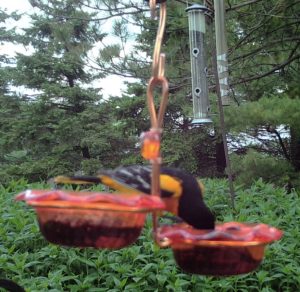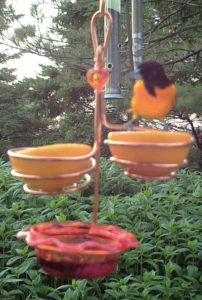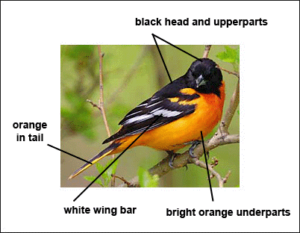Triple Oriole Item #007
Baltimore oriole – Icterus galbula
*Oriole’s are protected by law covering all migratory bird species, and, since 1975, by the State’s Nongame and Endangered Species Conservation Act (Chapter 27, Acts of 1975).
*Recently the Baltimore Oriole was combined with the western Bullock’s Oriole as a single species, the Northern Oriole. When trees were planted on the Great Plains, the two forms extended their ranges and met. Despite the differences in appearance, it was found that they interbred, and that most birds in the central plains were hybrids, so the birds were combined into a single species. Now, it seems that in some places the birds are choosing to mates of their own type, and they are considered separate species again.
Description: 7 – 8 ½”. Male has black head, back, wings, and tail; orange breast, rump, and shoulder patch. Female, olive-brown, with dull yellow-orange under-parts and two dull white wing bars. Both have a sharply pointed bill.
Voice: Clean and flute-like whistled single or double notes in short, deliberate whistles and chattering sounds high in the treetops
Habitat: Deciduous woodlands and shade trees. Before the decline, the American elm was a favorite nesting site for the eastern bird.
Placement: Place your feeder out in the open so it can be seen by the birds. Use a feeder hook if an open branch is not available.
Diet:
Oriole Species Foods Preferred
Altamira* Insects, fruit, berries
Audubon’s* Insects, fruit, nectar
Baltimore Insects, berries, fruit, nectar, peanut butter, suet
Bullock’s Insects, berries, fruit, suet, nectar
Hooded Insects, nectar, bread scraps (rare only), fruit
Orchard Insects, berries, flowers, nectar, fruit
Scott’s Insects, fruit, nectar
Spot-Breasted* Insects, fruit, berries, nectar
Streak-Backed* Insects, grubs, seeds, flowers, nectar
*Rare at feeders
All of these birds have a strong sweet tooth, and they prefer foods that offer not only the proper nutrition, but also have a touch of sugar. Popular oriole foods include:
- Insects, mealworms, and wasps
- Nectar, Oriole food with a 5:1 or 6:1 ratio of water to sugar
- Flowers and flower pieces, such as buds
- Fruits, particularly oranges, apples, peaches, berries, and bananas
- Suet mixed with bits of fruit, berries, or peanut butter
- Jelly, especially grape jelly
- Fresh, frozen, or dried peas




